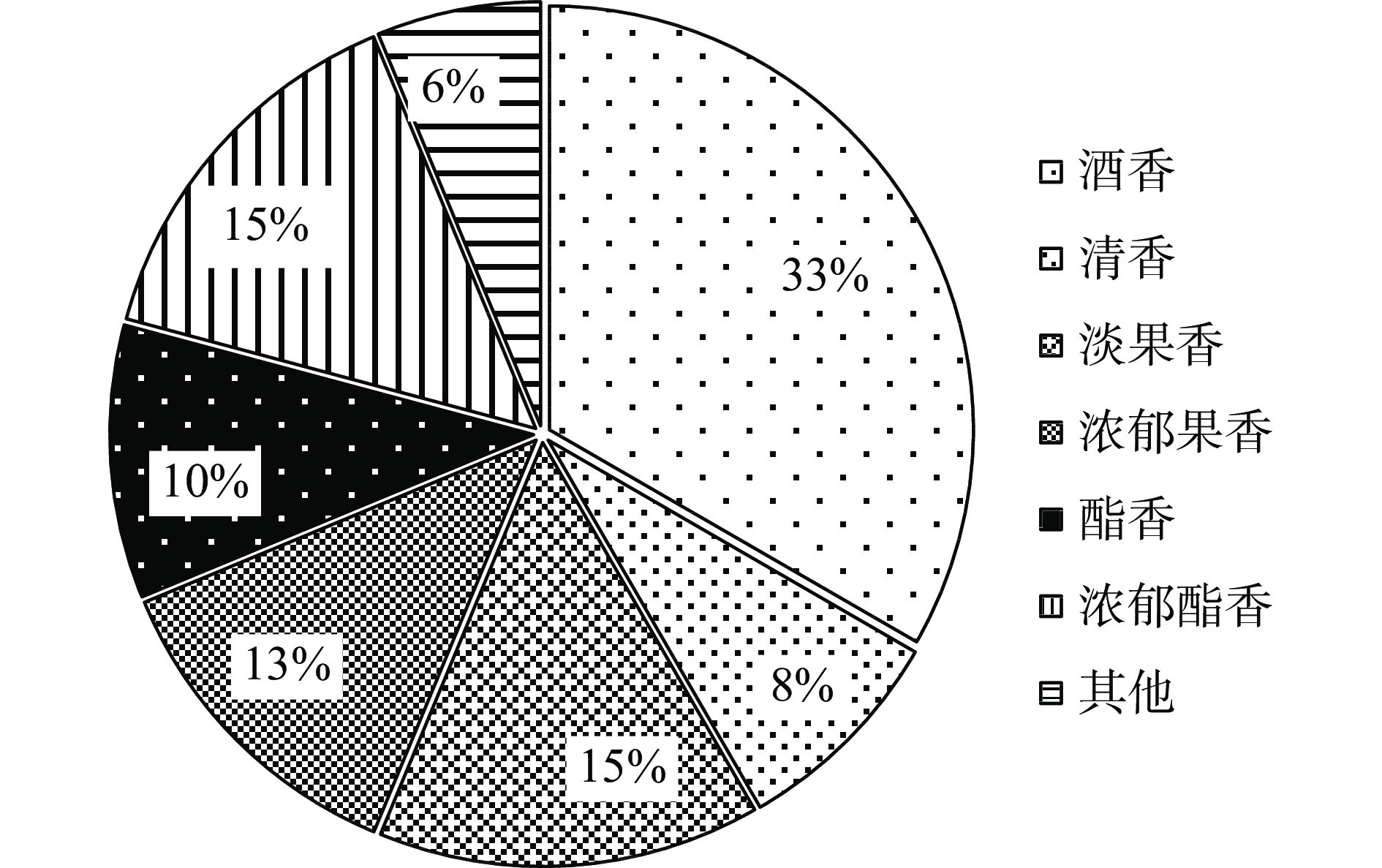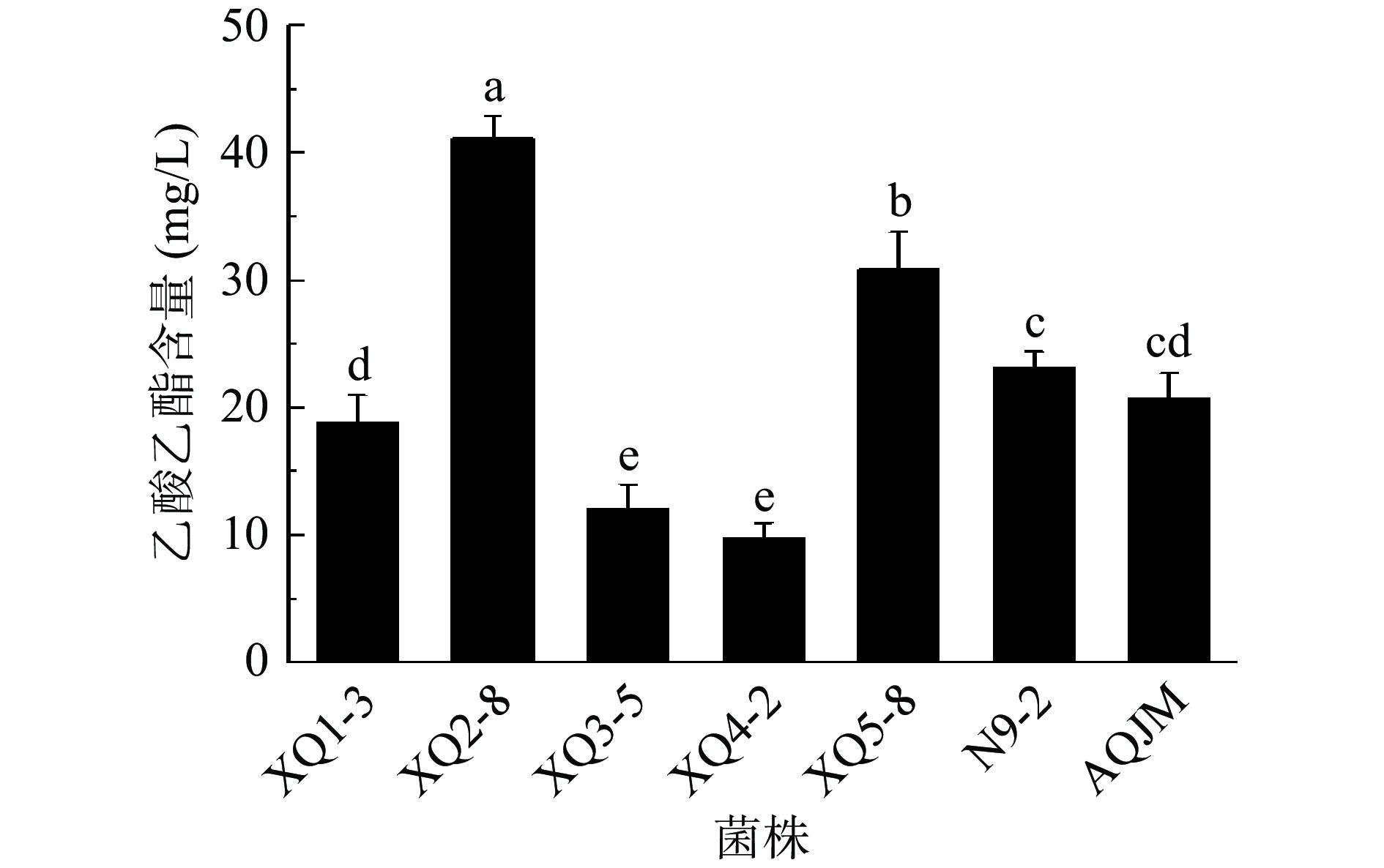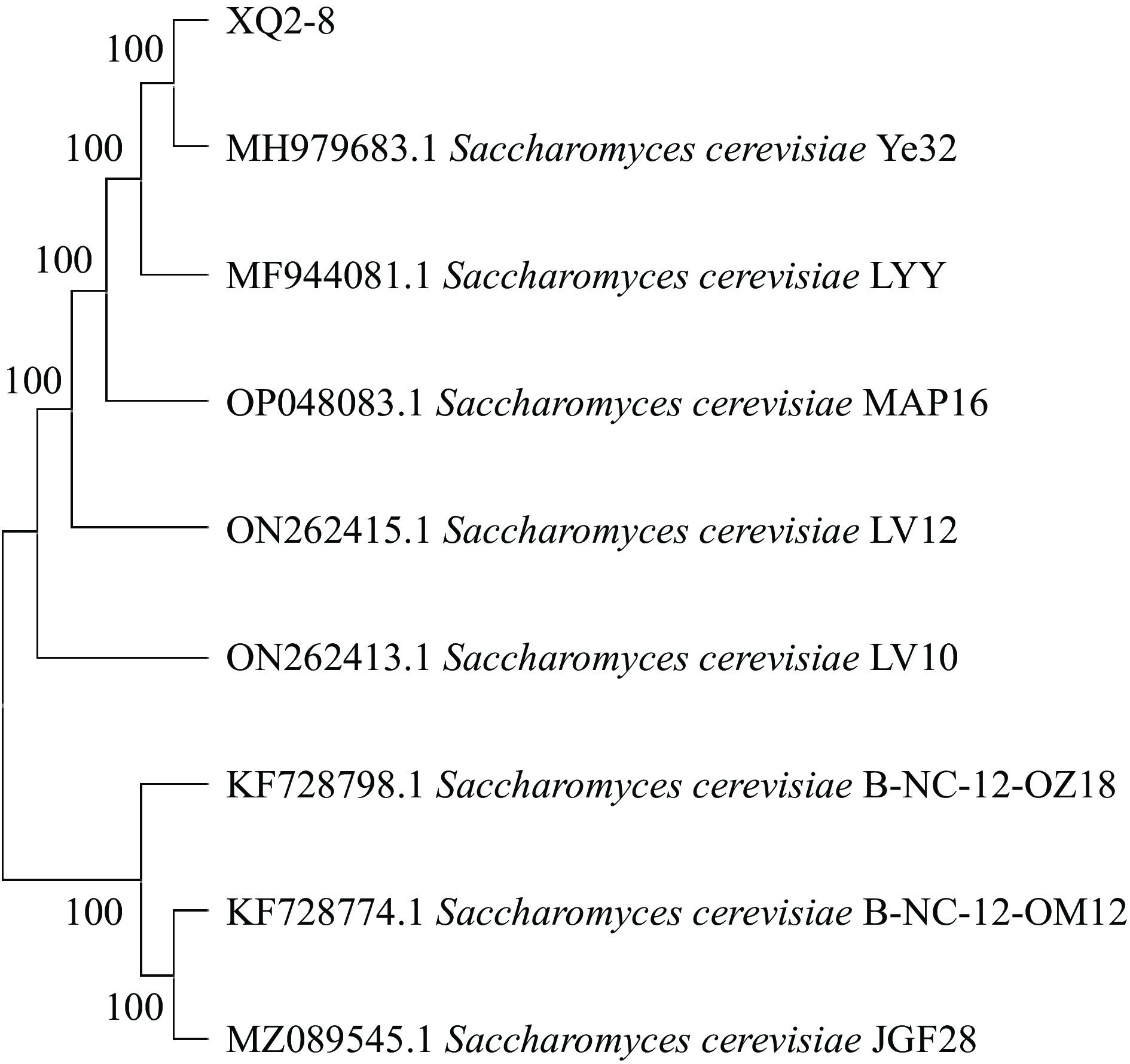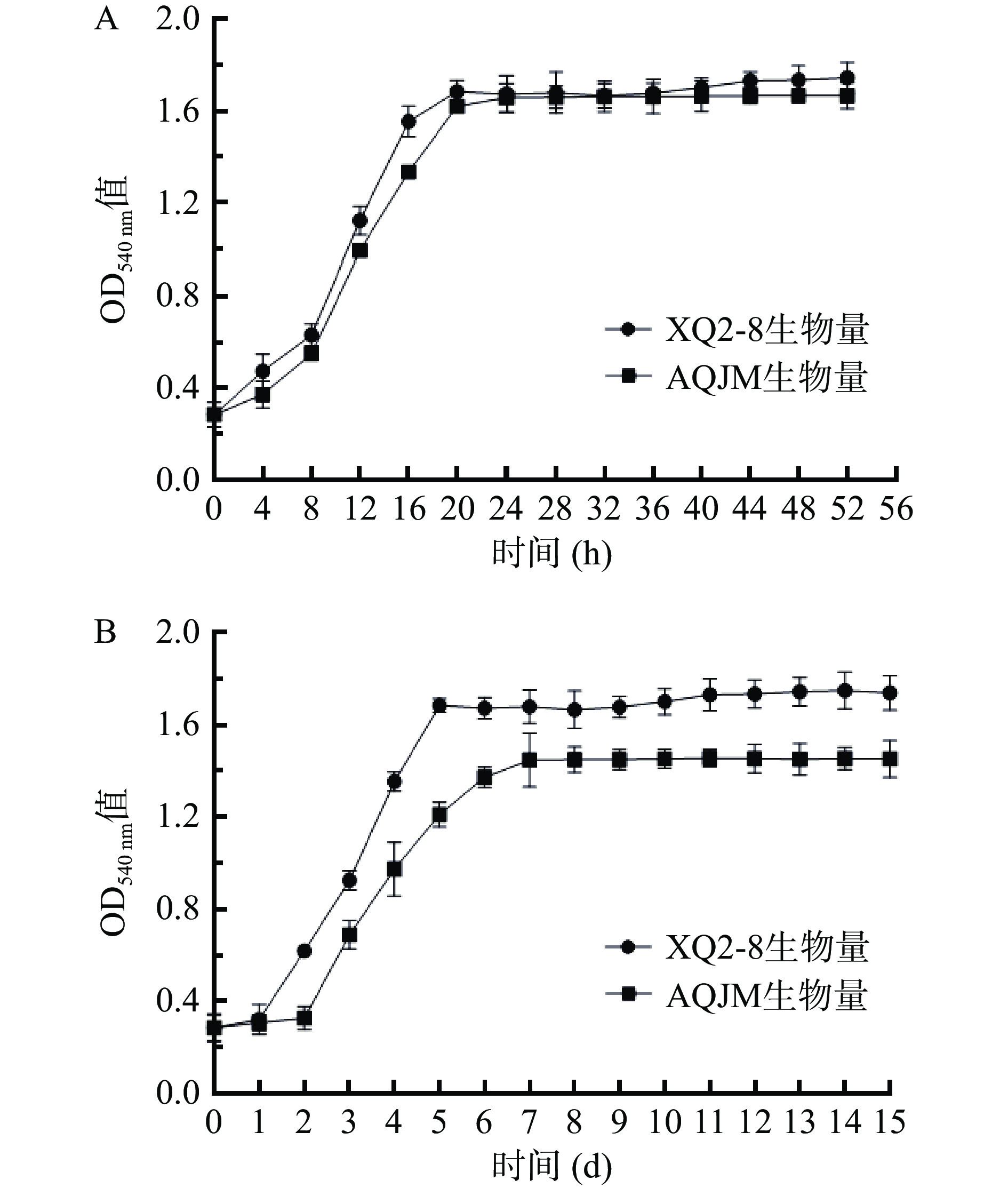Isolation and Identification of Cold Adaptive Yeast and Its Influence on the Quality of Low Temperature Brewing Rice Wine
-
摘要: 为筛选适合低温酿造米酒的酵母菌株,本研究从米曲中分离纯化、筛选出低温下产香舒适、发酵能力优良、产酒精能力和产酯能力强的酵母,通过形态观察及分子生物学方法对其进行菌种鉴定,分析其生长情况和耐受性,并将其应用于低温酿造米酒。结果表明,分离、筛选得到一株耐低温酵母菌株XQ2-8,经鉴定为酿酒酵母(Saccharomyces cerevisiae)。与对照菌株相比,菌株XQ2-8在15 ℃下生长曲线的延滞期变短、达到稳定期时的生物量更高,具有较好的耐低温特性。菌株XQ2-8对生长环境具有一定的耐受性,可在乙醇体积分数8%vol、葡萄糖含量60%、pH3.0、低温10 ℃条件下正常生长。利用菌株XQ2-8酿造米酒,与常温酿造相比,低温米酒的总酯含量(60.08 mg/L)和甘油含量(2.59 g/L)分别提高了15.6%、22.7%;总酸含量(1.91 g/L)和总高级醇含量(578.20 mg/L)分别降低了18.0%、17.7%;感官得分(89.47)提高了11.7%。说明利用筛选得到的菌株XQ2-8低温酿造可以改善米酒中酯类含量低、高级醇含量偏高的问题,提高米酒品质。Abstract: In order to screen yeast strains suitable for low-temperature brewing rice wine, this study isolated and purified and screened yeast with comfortable aroma production, excellent fermentation capacity, alcohol production capacity and ester production capacity at low temperature from rice bent, and identified the strain by morphological observation and molecular biology methods, analyzed its growth and tolerance, and applied it to low-temperature brewing rice wine. The results showed that a low temperature tolerant yeast strain XQ2-8 was isolated and screened, which was identified as Saccharomyces cerevisiae. Compared with the control strain, strain XQ2-8 had a shorter delayed growth curve and higher biomass when reaching the stable phase at 15 ℃, and had better low-temperature tolerance characteristics. The strain XQ2-8 was tolerant to the growth environment and could grow normally under the conditions of ethanol volume fraction 8%vol, glucose content 60%, pH3.0 and low temperature 10 ℃. When rice wine was brewed using strain XQ2-8, the total ester content (60.08 mg/L) and glycerol content (2.59 g/L) of low-temperature rice wine increased by 15.6% and 22.7%, respectively, the total acid content (1.91 g/L) and total higher alcohol content (578.20 mg/L) decreased by 18.0% and 17.7%, respectively, compared with room temperature brewing, and the sensory score (89.47) increased by 11.7%. This indicates that low temperature brewing using the screened strain XQ2-8 can improve the low ester content and high higher alcohol content in rice wine and improve the quality of rice wine.
-
米酒是一种以大米为原料的传统酒精饮料,因其香气浓郁、口感清爽而备受喜爱[1]。由于发酵原料以及发酵工艺的不同,米酒的风味与酱香型和浓香型白酒相比会显得相对单调[2]。米酒大多是常温发酵,常温下酵母生长和代谢旺盛,酵母快速增长过程中会因代谢产生大量高级醇类物质[3],大量高级醇会给酒体带来苦味、且具有较强的致醉性[4]。所以目前市面上米酒普遍存在酯类含量低、高级醇含量偏高的问题,其发展受到香味组分较少、容易致醉、饮后上头等关键问题的制约[5]。
低温发酵常被用于啤酒、日本清酒及白葡萄酒的生产中,被认为可以增加和保留更多的挥发性香气成分,从而改善发酵酒的风味[6]。Massera等[7]发现与25 ℃下发酵相比,低温发酵的葡萄酒具有更高的酯和更低的萜烯含量。Gamero等[8]发现低温发酵下生产的葡萄酒中甘油、乙基酯的产量显著上升。Urbina等[9]发现发酵温度与啤酒中高级醇的含量成正比。目前米酒酿造过程中少有采用低温发酵工艺的尝试。为了降低米酒中高级醇的含量、增加酯类物质含量,以提高米酒香气品质,本研究旨在利用低温酿造改善米酒品质。
为筛选适合低温酿造米酒的酵母菌株,本研究以从米曲中分离纯化出酵母为研究对象,测定其低温下产香情况、发酵能力、产乙醇能力和产酯能力,筛选出一株优良耐低温产香酵母,通过菌落形态观察并结合分子生物学鉴定筛选得到的酵母菌,并分析其生长特性和耐受性。利用筛选得到耐低温酵母,进行低温米酒发酵实验,分析低温米酒和常温米酒的理化指标及感官评价。该研究对低温发酵米酒的开发具有重要参考价值。
1. 材料与方法
1.1 材料与仪器
籼米 金龙鱼粮油食品股份有限公司;米曲样品来源于广西、四川、贵州、湖南、湖北等地的七种米曲;安琪酵母(Angel Saccharomyces cerevisiae) 安琪酵母股份有限公司;孟加拉红培养基 广东环凯生物科技有限公司;酵母粉、蛋白胨 赛默飞世尔科技有限公司;糖化酶(100000 U/g)、α-淀粉酶(40000 U/g) 上海阿拉丁生化科技股份有限公司;2,3,5-三苯基氯化四氮唑(2,3,5-triphenyltetrazolium chloride,TTC) 上海麦克林生化科技有限公司;其余试剂 均为国产分析纯。
HS-10顶空进样器、Nexis GC-2030气相色谱仪 日本岛津公司;BA200显微镜 麦克奥迪实业集团有限公司;MIR-150A恒温培养箱 上海SANTN公司;TD5A-WS台式高速离心机 湖南湘仪实验仪器开发有限公司;UV-2600紫外可见光分光光度计 日本岛津公司;A300聚合酶链式反应仪 杭州朗基科学仪器有限公司。
1.2 实验方法
1.2.1 培养基的配制
孟加拉红培养基(g/L):蛋白胨 5.0,KH2PO4 1.0,MgSO4 0.5,葡萄糖10.0,氯霉素0.1,孟加拉红0.033,琼脂20.0,121 ℃灭菌20 min;YPD固体培养基(g/L);酵母膏10,蛋白胨20,葡萄糖20,琼脂20,121°C灭菌20 min;米曲汁培养基:籼米500 g,淘洗干净后加水没过,浸泡5 h,上锅蒸煮直至大米煮熟,冷却,拌入米根霉,30 ℃培养40 h。然后加水淹没培养物,60 ℃糖化6 h,过滤,将滤液糖度调至15°Bx,pH调至6;米曲汁固体培养基:米曲汁培养基中加入2%的琼脂;TTC上层培养基(g/L):2,3,5-三苯基氯化四氮唑(TTC)0.5,葡萄糖5,琼脂15;TTC下层培养基(g/L):MgSO4 0.4,KH2PO4 1.0,酵母浸出粉1.5,蛋白胨2,葡萄糖10,琼脂20,调节pH至5.5。
1.2.2 酵母菌种的分离纯化
根据参考文献[10]的方法并加以修改,称取0.1 g米曲溶于10 mL无菌水中,30 ℃、170 r/min摇床培养30 min,静置取上层菌悬液,梯度稀释涂布于孟加拉红琼脂平板上,30 ℃培养24 h,挑取符合酵母菌落形态的菌株,采用平板划线法接于YPD固体培养基上,30 ℃培养48 h,纯化得到纯菌株。将纯化得到的菌株接种于YPD培养基中,150 r/min、30 ℃摇床培养24 h得到种子液,种子液稀释至107 CFU/mL,4 ℃保存备用。
1.2.3 耐低温产香酵母的筛选
1.2.3.1 酵母的初筛
将分离纯化得到的菌株接种于米曲汁固体培养基平板上,15 ℃培养至菌落成型,通过嗅闻法[11]对酵母菌株进行香气评价,排除其中香气不协调、不舒适的菌落,初步筛选具有酯香、甜香、酒香等香气的菌株进行复筛。
1.2.3.2 酵母的二级筛选
将初筛得到的菌株种子液分别以2%的接种量接种于盛有倒置杜氏小管的米曲汁培养基中,采用杜氏小管发酵法[12],170 r/min、15 ℃摇床培养,观察杜氏管内气体的产生情况,记录气泡在杜氏小管中的高度,筛选产气多且快的酵母进行三级筛选。
1.2.3.3 酵母的三级筛选
将二级筛选得到的菌株划线接种于TTC下层培养基上,15 ℃下培养至菌落成型,倒入TTC上层培养基,15 ℃下遮光培养2~3 h,观察培养皿上菌落的显色情况[13]。菌落颜色越红,菌株的产乙醇能力越强,筛选出产乙醇能力强的酵母进行四级筛选。
1.2.3.4 酵母的四级筛选
将三级筛选得到的菌株种子液分别以2%的接种量接种于米曲汁培养基中,15 ℃摇床培养15 d后,取发酵液2 mL进行乙酸乙酯含量的测定,采用气相色谱法,参考黄慧芬[14],筛选产乙酸乙酯能力最好的菌株。
1.2.4 耐低温产香酵母的鉴定
1.2.4.1 形态学观察
取一环纯化后的菌株在YPD平板上划线,30 ℃培养48 h,取平板进行观察。用接种针沾取菌苔于载玻片上,滴加1滴无菌水,盖上盖玻片,于光学显微镜下10×40倍观察菌株细胞形态。
1.2.4.2 分子生物学鉴定
使用真菌通用引物ITS1(5'-TCCGTAGGTGAACCTGCGG-3')、ITS4(5'-TCCTCCGCTTATTGATATGC-3')扩增菌株的ITS序列;PCR反应体系:预混酶20 μL;引物ITS1、ITS4各2 μL;菌液2 μL;ddH2O 15 μL。扩增条件:预变性98 ℃、2 min;变性 98 ℃、10 s;退火56 ℃、10 s;延伸72 ℃、10 s/kb,循环35次;再延伸72 ℃、5 min;4 ℃保存。将扩增好的PCR产物进行琼脂糖凝胶电泳。电泳条带送至武汉擎科生物公司测序。测序结果提交于美国国立生物技术信息中心(National Center for Biotechnology Information,NCBI)的GenBank数据库中,采用基本局部比对搜索工具(basic local alignment search tool,BLAST)进行同源性搜索,选取同源性较高的模式菌株的ITS rRNA基因序列,使用MEGAX软件中的邻接法构建系统发育树。
1.2.5 耐低温产香酵母的生长曲线测定
根据参考文献[15]的方法并加以修改,酵母种子液以2%的接种量接种至YPD培养基中,分别于30 ℃、15 ℃,150 r/min摇床培养。定时取样测定OD540 nm值,以时间为横坐标,OD540 nm值为纵坐标,绘制出菌株的生长曲线;同时绘制安琪酿酒酵母(AQJM)的生长曲线作为对照。
1.2.6 耐低温产香酵母的耐受性实验
1.2.6.1 乙醇耐受性
酵母种子液以2%的接种量接种至不同乙醇浓度(0%vol、2%vol、4%vol、6%vol、8%vol、10%vol、12%vol)的YPD培养基,30 ℃、150 r/min摇床培养24 h,测定OD540 nm值,比较生长情况。
1.2.6.2 糖耐受性
酵母种子液以2%的接种量接种至不同葡萄糖含量(2%、10%、20%、30%、40%、50%、60%)的YPD培养基,30 ℃、150 r/min摇床培养24 h,测定OD540 nm值,比较生长情况。
1.2.6.3 酸耐受性
酵母种子液以2%的接种量接种至不同pH(乙酸调,3.0、3.5、4.0、4.5、5.0、5.5、6.0)的YPD培养基,30 ℃、150 r/min摇床培养24 h,测定OD540 nm值,比较生长情况。
1.2.6.4 温度耐受性
酵母种子液以2%的接种量接种至YPD培养基,分别于不同温度(10、15、20、25、30、35、40 ℃)下、150 r/min摇床培养48 h,测定OD540 nm值,比较生长情况。
1.2.7 耐低温产香酵母低温酿造米酒实验
根据参考文献[16]的方法并加以修改,250 g籼米浸泡3 h后,按料液比1:3籼米与水混合,用打浆机磨浆。加入10 U/g高温α-淀粉酶,温度90 ℃、液化时间45 min,冷却至室温,加入糖化酶250 U/g,温度60 ℃,糖化时间60 min,冷却至室温,以2%的接种量接种酵母XQ2-8种子液,置于锥形瓶中封口膜密封,在15 ℃下发酵,监测其失重,当24 h内失重<0.02 g时视为发酵结束,记录其发酵时长,发酵结束后离心过滤获得米酒,并以30 ℃下发酵获得的米酒作为对照。
1.2.8 米酒理化指标分析及感官评价
还原糖含量的测定:采用DNS法[17];总酸、酒精度及pH的测定:参照GB/T 13662-2018黄酒中方法[18];总酯含量的测定:采用皂化回流法[19];总高级醇含量的测定:采用气相色谱法,参考黄慧芬[14];感官评价:感官评价小组由10位经过训练的品评师组成,实验在食品感官品评室中进行,样品随机呈现。香气、滋味、色泽、典型性4个维度,每个维度25分,总分为100分,具体评分标准见表1。
表 1 米酒感官评价标准Table 1. Sensory evaluation criteria for rice wine评价指标 评价标准 分值范围 香气
(25分)米香、酒香浓郁、纯正 21~25 米香、酒香纯正,但不浓郁 11~20 米香、酒香不足 0~10 滋味
(25分)酸甜适宜,酒体柔和清爽,风味协调 21~25 酸甜较适中,酒体较柔和爽口,风味较协调 11~20 酒体寡谈无味,或来带杂异味,酒体协调性较差 0~10 色泽
(25分)有光泽,有微量沉淀物,无外来杂质 21~25 有光泽,有大量沉淀物,无外来杂质 11~20 无光泽,有大量沉淀物,有外来杂质 0~10 典型性
(25分)具有明显米香或发酵酒特征风味 21~25 具有较为明显米香或发酵酒特征风味 11~20 米香或发酵果酒香味较弱,发酵酒特征风味弱 0~10 1.3 数据处理
利用Excel、SPSS、GraphPad Prism 8软件对数据进行分析处理,使用MEGA11软件构建系统发育树。实验均进行3次重复,结果表示为“平均值±标准偏差”。
2. 结果与分析
2.1 耐低温产香酵母的初筛
从多个米曲样本中分离、纯化后共得到69株品质优良、性状稳定的酵母菌,将得到的菌株接种于米曲汁固体培养基平板上,嗅闻法对各酵母菌株进行香气评价,排除其中香气不协调、不舒适的菌落,初步筛选得到47株产香舒适的菌株,根据菌株样本的米曲来源进行编号。初步筛选的目的是为了选出具有产香能力的酵母菌,由图1所示,本实验筛选所得酵母的香气类型可分为7类,按其占比从高至低包括:酒香共15株占比33%、淡果香共7株占比15%、浓郁酯香共7株占比15%、浓郁果香共6株占比13%、酯香共5株占比10%、清香共4株占比8%和其他(中药香和烟熏香)共3株占比6%。
2.2 耐低温产香酵母的二级筛选
初次筛选得到的47株有产香能力的酵母菌株采用杜氏管发酵法,以发酵过程中酵母的产气情况来表达菌株的发酵能力[20]。初筛后得到的47株产香酵母以及对照菌株安琪酿酒酵母(AQJM)的产气情况见表2,有38株酵母具有产气能力,其中有10株酵母菌株发酵管中杜氏小管中空气高度高于30 mm,具有极强的产气能力,菌株编号分别是XQ1-3、XQ2-8、XQ3-5、XQ4-2、XQ4-3、XQ5-8、XQ6-2、y-8、YRJM、N9-2,这些菌株相比于其他菌株有更强的发酵能力。因此,选择具有较好低温下发酵能力的10株产香酵母进行下一步筛选。
表 2 杜氏小管筛选产气结果Table 2. Duchenne tubule screening results of gas production菌株
编号长度
(mm)菌株
编号长度
(mm)菌株
编号长度
(mm)菌株
编号长度
(mm)LQ1-1 4.2 XQ5-3 0.1 XQ7-5 8.1 y-8 32.2 LQ1-5 3.0 XQ5-5 1.2 XQ7-6 3.7 y-9 0.0 LQ2-4 3.7 XQ5-6 3.7 XQ8-2 0.0 y-10 0.0 LQ2-5 2.1 XQ5-8 32.6 XQ8-5 2.1 11JM 0.1 LQ4-3 4.0 XQ6-2 30.4 XQ8-6 1.0 CZJM 0.0 LQ5-1 12.5 XQ6-4 28.1 y-1 0.0 YRJM 32.5 XQ1-3 34.9 XQ6-5 0.2 y-2 0.0 YRNN 7.1 XQ2-8 47.8 XQ6-7 4.1 y-3 1.0 N9-2 40.9 XQ3-5 38.1 XQ6-8 21.4 y-4 1.3 N24-2 1.1 XQ3-7 27.2 XQ7-1 26.1 y-5 0.0 N10-2 1.0 XQ4-2 43.0 XQ7-2 29.6 y-6 3.1 N20-2 3.0 XQ4-3 36.9 XQ7-4 19.1 y-7 2.6 AQJM 38.0 2.3 耐低温产香酵母的三级筛选
TTC是一种显色剂,能与酵母代谢物发生显色反应,可以用来判断酵母产乙醇能力的强弱[21]。观察培养皿中菌落的颜色,产乙醇能力越强的菌株菌落呈现深红色,产乙醇能力弱的菌株菌落呈现粉红色或不显色。结果如表3所示,菌株XQ1-3、XQ4-2、XQ5-8、N9-2、XQ2-8、XQ3-5在TTC培养基上的颜色与对照菌株安琪酿酒酵母(AQJM)的颜色相当或更深,说明其产酒精能力与对照菌株AQJM相当或更强。因此,选择XQ1-3、XQ2-8、XQ3-5、XQ4-2、XQ5-8、N9-2进行下一步筛选。
表 3 酵母菌在TTC培养基上的显色结果Table 3. Color development results of yeast cultured on TTC medium菌株编号 XQ1-3 XQ2-8 XQ3-5 XQ4-2 XQ4-3 XQ5-8 XQ6-2 y-8 YRJM N9-2 AQJM 显色结果 +++ ++++ ++++ +++ ++ +++ ++ + + +++ +++ 注:“++++”表示颜色为深红色;“+++”表示颜色为红色;“++”表示颜色为粉红色;“+”表示颜色为浅粉色;“−”表示无颜色变化。 2.4 耐低温产香酵母的四级筛选
产酯能力强的酵母可对米酒的感官品质起到修饰、提高作用。乙酸乙酯被广泛认为是米酒、黄酒等以大米为原料的发酵酒的特征香气物质[22]。乙酸乙酯能赋予发酵食品以水果香,是酒精饮料中最为常见的乙酯类香气物质,存在于所有香型的酒类中[23]。如图2所示,在相同发酵条件下各酵母菌株的产乙酸乙酯能力差异较大,其中酵母XQ2-8的产乙酸乙酯的含量最高,为41.2 mg/L。因此选择菌株XQ2-8进行后续实验。
2.5 酵母XQ2-8的鉴定
2.5.1 酵母XQ2-8形态学观察
将酵母XQ2-8在YPD平板中划线,30 ℃培养至菌落成型,菌落形态如图3A,菌落长势良好,呈乳白色、质地均匀、呈圆形、边缘整齐、湿润黏稠易挑起;显微镜下细胞形态特征如图3B,细胞呈卵圆形,出芽生殖,无鞭毛及假丝,属酵母的典型特征。
2.5.2 酵母XQ2-8分子生物学鉴定
对筛选到的酵母XQ2-8进行ITS序列测序,数据在NCBI数据库中登录,序列号为OR003908,并进行BLAST比对,用MEGA-X软件绘制菌株XQ2-8基因序列相关菌株的系统发育树,结果见图4。菌株XQ2-8与MH979683.1 Saccharomyces cerevisiae聚在一个分支上;再结合菌落形态、镜检结果分析,确定菌株XQ2-8为酿酒酵母(Saccharomyces cerevisiae)。
2.6 酵母XQ2-8的生长曲线
酵母XQ2-8在YPD培养基中30 ℃和15 ℃下培养的生长曲线如图5,酵母XQ2-8在30 ℃下培养,在0~8 h为迟缓期,生长速率缓慢;8~20 h为对数生长期,生长速率最大;20 h后进入稳定期,OD540 nm值基本保持在1.68。酵母XQ2-8在15 ℃下培养,在0~1 d为迟缓期,相比30 ℃下迟缓期延长;1~5 d为对数生长期;5 d后进入稳定期,OD540 nm值基本保持在1.65。酵母XQ2-8在30 ℃下的生长曲线与对照菌株安琪酿酒酵母(AQJM)基本一致,但15 ℃下安琪酿酒酵母延滞期更长为2 d,2~7 d为对数生长期,7 d后进入稳定期,且达到稳定后的生物量也降低。在生产中延滞期短的菌株有更好的适应能力[24],可在短时间内形成优势,减少副产物的形成,缩短发酵周期,有利于提高发酵效率。说明酵母XQ2-8具有耐低温性,适用于低温下酿造米酒。
2.7 酵母XQ2-8的耐受性分析
高浓度乙醇会抑制酵母菌细胞的生长,影响其发酵效果[25]。具有一定耐乙醇能力的酵母能够使发酵更加完全、彻底[26]。酵母XQ2-8对乙醇的耐受性见图6a,随着乙醇体积分数增加,酵母XQ2-8的生物量逐渐降低,耐受能力逐渐减弱。在乙醇浓度为8%vol时,酵母呈现微弱生长;在乙醇浓度>8%vol时,酵母的生长基本停止。米酒的酒精度多为3%vol~7%vol,说明酵母XQ2-8能够在米酒发酵过程中正常生长。王奇盛[27]从酒醅中分离出的酿酒酵母在8%vol的乙醇浓度下生长能力显著降低,与本文结果一致。
葡萄糖是酵母菌发酵的营养来源,但过高的葡萄糖含量会抑制酵母菌的生长[28]。应用于生产中的酵母菌株应具备良好葡萄糖耐受能力[29]。杨宁等[30]将从白酒酒醅中分离出的酵母JM2与安琪酿酒酵母对比,发现二者在葡萄糖含量50%的条件下基本停止生长。酵母XQ2-8对葡萄糖的耐受性见图6b,随着葡萄糖含量的增加,酵母XQ2-8的OD540 nm值降低。当葡萄糖含量>30%时,酵母的生物量明显下降,但在葡萄糖含量为60%时,酵母XQ2-8仍可生长。说明该菌种葡萄糖耐受性较好,可用于米酒生产发酵。
酵母菌最适生长pH通常为4~5,发酵过程中产生的酸性物质会导致体系酸度的变化。张乐等[31]发现,酿酒酵母具有一定的酸耐受性有利于提升酵母的发酵速率。应用于生产的酵母应具备良好的耐酸性。酵母XQ2-8对酸的耐受性见图6c。当pH为3.0~6.0时,随着pH不断升高,酵母XQ2-8的生物量逐渐升高至稳定,当pH为5.5时菌株的生长状况最佳,在pH为3.0时菌株生物量低但仍可生长,米酒的pH在3.8~4.5之间[32],说明酵母XQ2-8能够适应米酒酿造过程中的pH环境。陈丽花等[10]从甜酒曲中分离的多株酵母在pH3.0~11.0之间均能生长,这与本实验结果相似。
温度会直接影响酵母的生长繁殖,温度较高,酵母生长较快容易加速衰亡,温度较低会导致酵母生长周期变长[33]。本文旨在利用低温发酵米酒,故对于所筛选菌株的低温耐受性至关重要。酵母XQ2-8对温度的耐受性见图6d。酵母XQ2-8在10~35 ℃范围内均能生长,在25 ℃条件生长情况最好,且在10 ℃下仍有一定生长能力,说明酿酒酵母XQ2-8具有一定的低温耐受性,能够适用于低温发酵米酒。
2.8 酵母XQ2-8对低温发酵米酒品质的影响
利用上述实验筛选得到耐低温酵母XQ2-8,进行低温米酒发酵实验,同时以30 ℃下发酵的米酒为对照组,15 ℃和30 ℃下发酵时长分别是13 d和6 d,发酵结束后其理化指标及感官得分见表4,低温米酒残糖量和酒精度分别为5.61 g/L、7.81%vol,与常温米酒无显著差异(P>0.05),且符合米酒标准NY/T 1885-2017《绿色食品 米酒》[34]。总酸含量1.91 g/L、总酯含量60.08 mg/L、甘油含量2.59 g/L、高级醇含量578.20 mg/L、感官评分89.47,与常温米酒差异显著(P<0.05)。相比30 ℃下酿造的米酒,15 ℃下酿造的米酒总酯含量提高15.6%、甘油含量提高22.7%、高级醇含量降低17.7%,这一结果与Molina等[35]、Beltran等[36]对比低温常温下发酵葡萄酒、啤酒的结果相似。目前米酒中酯类含量相对较低,高级醇含量相对高于其他酒种,酯类含量低使米酒香味寡淡[37],高级醇含量高使酒体呈现苦味[38],具有较强的致醉性[39]。甘油是酵母酒精发酵过程中主要副产物之一[40],可为酒体提供圆润、柔滑口感,一定含量甘油可增加米酒复杂性[41]。低温酿造使米酒中酯类、甘油含量提高,高级醇含量降低,可以改善米酒品质。
表 4 米酒理化指标分析Table 4. Analysis of physicochemical indexes of rice wine指标 15 ℃酿造 30 ℃酿造 显著性 NY/T
1885-2017总酸含量(g/L) 1.91±0.02 2.33±0.03 * 0.5~10 残糖量(g/L) 5.61±0.05 5.47±0.07 ns ≥2.5 酒精度(%vol) 7.81±0.06 7.92±0.23 ns >0.5 总酯含量(mg/L) 60.08±1.5 51.97±1.9 * − 甘油含量(g/L) 2.59±0.03 2.11±0.03 * − 高级醇含量(mg/L) 578.20±27.03 702.31±49.17 ** − 感官评分 89.47±1.5 80.12±1.5 ** − 注:ns表示没有显著性差异;*表示对应P<0.05差异的显著性;**表示对应P<0.01差异的显著性;−表示标准中无规定。 3. 结论
本文以从米曲中筛选得到的69株酵母菌株为研究对象,比较其低温下的产香、发酵、产酒精和产酯能力,获得1株低温下发酵性能优良且产香能力强的菌株XQ2-8,经鉴定为酿酒酵母(Saccharomyces cerevisiae)。在低温下菌株XQ2-8比对照菌株生长延滞期更短、达到稳定时生物量更高,生长周期更短,具有良好的耐低温特性;菌株XQ2-8可在乙醇体积分数8%vol、葡萄糖含量60%、pH3.0、低温10 ℃的条件下生长。利用菌株XQ2-8低温酿造米酒发现,与常温酿造米酒相比,低温米酒的总酯含量和甘油含量分别提高了15.6%和22.7%;总酸含量和总高级醇含量分别降低了18.0%和17.7%、感官得分提高了11.7%,说明菌株XQ2-8低温酿造米酒能有效改善米酒饮后上头、风味组分少的问题,提高米酒品质。
本研究筛选了一株适用于低温酿造米酒的优良菌株,且利用该菌株低温酿造米酒能够有效提高米酒的风味品质,对于开发低温米酒酿造工艺有较强的工业应用价值。但目前低温发酵仍然存在发酵周期长的问题,不利于大规模工业化生产。在未来,对低温米酒酿造工艺的优化还有待深入研究。
-
表 1 米酒感官评价标准
Table 1 Sensory evaluation criteria for rice wine
评价指标 评价标准 分值范围 香气
(25分)米香、酒香浓郁、纯正 21~25 米香、酒香纯正,但不浓郁 11~20 米香、酒香不足 0~10 滋味
(25分)酸甜适宜,酒体柔和清爽,风味协调 21~25 酸甜较适中,酒体较柔和爽口,风味较协调 11~20 酒体寡谈无味,或来带杂异味,酒体协调性较差 0~10 色泽
(25分)有光泽,有微量沉淀物,无外来杂质 21~25 有光泽,有大量沉淀物,无外来杂质 11~20 无光泽,有大量沉淀物,有外来杂质 0~10 典型性
(25分)具有明显米香或发酵酒特征风味 21~25 具有较为明显米香或发酵酒特征风味 11~20 米香或发酵果酒香味较弱,发酵酒特征风味弱 0~10 表 2 杜氏小管筛选产气结果
Table 2 Duchenne tubule screening results of gas production
菌株
编号长度
(mm)菌株
编号长度
(mm)菌株
编号长度
(mm)菌株
编号长度
(mm)LQ1-1 4.2 XQ5-3 0.1 XQ7-5 8.1 y-8 32.2 LQ1-5 3.0 XQ5-5 1.2 XQ7-6 3.7 y-9 0.0 LQ2-4 3.7 XQ5-6 3.7 XQ8-2 0.0 y-10 0.0 LQ2-5 2.1 XQ5-8 32.6 XQ8-5 2.1 11JM 0.1 LQ4-3 4.0 XQ6-2 30.4 XQ8-6 1.0 CZJM 0.0 LQ5-1 12.5 XQ6-4 28.1 y-1 0.0 YRJM 32.5 XQ1-3 34.9 XQ6-5 0.2 y-2 0.0 YRNN 7.1 XQ2-8 47.8 XQ6-7 4.1 y-3 1.0 N9-2 40.9 XQ3-5 38.1 XQ6-8 21.4 y-4 1.3 N24-2 1.1 XQ3-7 27.2 XQ7-1 26.1 y-5 0.0 N10-2 1.0 XQ4-2 43.0 XQ7-2 29.6 y-6 3.1 N20-2 3.0 XQ4-3 36.9 XQ7-4 19.1 y-7 2.6 AQJM 38.0 表 3 酵母菌在TTC培养基上的显色结果
Table 3 Color development results of yeast cultured on TTC medium
菌株编号 XQ1-3 XQ2-8 XQ3-5 XQ4-2 XQ4-3 XQ5-8 XQ6-2 y-8 YRJM N9-2 AQJM 显色结果 +++ ++++ ++++ +++ ++ +++ ++ + + +++ +++ 注:“++++”表示颜色为深红色;“+++”表示颜色为红色;“++”表示颜色为粉红色;“+”表示颜色为浅粉色;“−”表示无颜色变化。 表 4 米酒理化指标分析
Table 4 Analysis of physicochemical indexes of rice wine
指标 15 ℃酿造 30 ℃酿造 显著性 NY/T
1885-2017总酸含量(g/L) 1.91±0.02 2.33±0.03 * 0.5~10 残糖量(g/L) 5.61±0.05 5.47±0.07 ns ≥2.5 酒精度(%vol) 7.81±0.06 7.92±0.23 ns >0.5 总酯含量(mg/L) 60.08±1.5 51.97±1.9 * − 甘油含量(g/L) 2.59±0.03 2.11±0.03 * − 高级醇含量(mg/L) 578.20±27.03 702.31±49.17 ** − 感官评分 89.47±1.5 80.12±1.5 ** − 注:ns表示没有显著性差异;*表示对应P<0.05差异的显著性;**表示对应P<0.01差异的显著性;−表示标准中无规定。 -
[1] JIAO A, XU X, JIN Z. Research progress on the brewing techniques of new-type rice wine[J]. Food Chemistry,2017,215(Jan.15):508−515.
[2] 田瑞杰. 中温大曲原核微生物群落解析及高产淀粉酶菌株的筛选与应用探究[D]. 郑州:郑州轻工业大学, 2022. [TIAN R J. Analysis of prokaryotic microbial community and screening and application of high amylase producing strain in medium-temperature Daqu[D]. Zhengzhou:Zhengzhou University of Light Industry, 2020.] TIAN R J. Analysis of prokaryotic microbial community and screening and application of high amylase producing strain in medium-temperature Daqu[D]. Zhengzhou: Zhengzhou University of Light Industry, 2020.
[3] 张志勇, 刘震, 周峻岗, 等. 微生物与发酵工艺对苹果酒品质影响的研究概述[J]. 食品与发酵工业,2022,48(19):287−294. [ZHANG Z Y, LIU Z, ZHOU J G, et al. Effect of microorganisms and fermentation process on the quality of apple cider:A review[J]. Food and Fermentation Industries,2022,48(19):287−294.] ZHANG Z Y, LIU Z, ZHOU J G, et al . Effect of microorganisms and fermentation process on the quality of apple cider: A review[J]. Food and Fermentation Industries,2022 ,48 (19 ):287 −294 .[4] 袁国亿, 何宇淋, 王春晓, 等. 米酒风味品质形成相关因素的研究进展[J]. 食品与发酵工业,2022,48(9):286−294. [YUAN G Y, HE Y L, WANG C X, et al. Research progress on the factors correlated with flavor quality in rice wine[J]. Food and Fermentation Industries,2022,48(9):286−294.] YUAN G Y, HE Y L, WANG C X, et al . Research progress on the factors correlated with flavor quality in rice wine[J]. Food and Fermentation Industries,2022 ,48 (9 ):286 −294 .[5] 覃凤阳, 黄志久, 吴正云, 等. 辣蓼、黄精和枸杞提取液的添加对米香型白酒酿造的影响[J]. 食品科技,2022,47(1):113−117. [QIN F Y, HUANG Z J, WU Z Y, et al. Effects of adding Polygonumn hydropiper, Polygonum cyrtonema and Lycium barbarum extracts on the fermentation process of rice-flavor Baijiu[J]. Food Science and Technology,2022,47(1):113−117.] QIN F Y, HUANG Z J, WU Z Y, et al . Effects of adding Polygonumn hydropiper, Polygonum cyrtonema and Lycium barbarum extracts on the fermentation process of rice-flavor Baijiu[J]. Food Science and Technology,2022 ,47 (1 ):113 −117 .[6] 盛凤云, 徐俊敏, 宋科峰, 等. 发酵温度对黄酒酿造及风味物质形成影响研究[J]. 酿酒科技,2021,323(5):56−61. [SHENG F Y, XU J M, SONG K F, et al. Effect of low temperature on the fermentation process and flavor quality of Huangjiu[J]. Liquor-Making Science & Technology,2021,323(5):56−61.] SHENG F Y, XU J M, SONG K F, et al . Effect of low temperature on the fermentation process and flavor quality of Huangjiu[J]. Liquor-Making Science & Technology,2021 ,323 (5 ):56 −61 .[7] MASSERA A, ASSOF M, SARI S, et al. Effect of low temperature fermentation on the yeast-derived volatile aroma composition and sensory profile in Merlot wines[J]. LWT,2021,142:111069. doi: 10.1016/j.lwt.2021.111069
[8] GAMERO A, TRONCHONI J, QUEROL A, et al. Production of aroma compounds by cryotolerant Saccharomyces species and hybrids at low and moderate fermentation temperatures[J]. Journal of Applied Microbiology,2013,114(5):1405−1414. doi: 10.1111/jam.12126
[9] URBINA K, VILLARREAL P, NESPOLO R F, et al. Volatile compound screening using HS-SPME-GC/MS on Saccharomyces eubayanus strains under low-temperature pilsner wort fermentation[J]. Microorganisms,2020,8(5):755. doi: 10.3390/microorganisms8050755
[10] 陈丽花, 任丽霞, 李东娜, 等. 甜酒曲中优质酵母菌的分离鉴定及其产香特性分析[J]. 食品科学,2021,42(6):142−149. [CHEN L H, REN L X, LI D N, et al. Fermentation characteristics for flavor compounds production by quality yeast strains isolated from rice wine starters[J]. Food Science,2021,42(6):142−149.] CHEN L H, REN L X, LI D N, et al . Fermentation characteristics for flavor compounds production by quality yeast strains isolated from rice wine starters[J]. Food Science,2021 ,42 (6 ):142 −149 .[11] 彭璐, 明红梅, 陶敏, 等. 樱桃酒酿造用产香酵母的筛选及其特征香气成分分析[J]. 中国酿造,2020,39(11):36−42. [PENG L, MING H M, TAO M, et al. Screening of aroma-producing yeast for cherry wine brewing and analysis of its characteristic aroma components[J]. China Brewing,2020,39(11):36−42.] PENG L, MING H M, TAO M, et al . Screening of aroma-producing yeast for cherry wine brewing and analysis of its characteristic aroma components[J]. China Brewing,2020 ,39 (11 ):36 −42 .[12] 张小勤, 潘晓姗, 李东, 等. 贵州产地刺梨果酒产酒精酵母的筛选及其发酵性能研究[J]. 中国酿造,2022,41(12):97−102. [ZHANG X Q, PAN X S, LI D, et al. Screening and fermenting property of alcohol-producing yeasts in Rosa roxbunghii from Guizhou[J]. China Brewing,2022,41(12):97−102.] ZHANG X Q, PAN X S, LI D, et al . Screening and fermenting property of alcohol-producing yeasts in Rosa roxbunghii from Guizhou[J]. China Brewing,2022 ,41 (12 ):97 −102 .[13] 张二豪, 何萍, 刘盼盼, 等. 西藏沙棘酵母菌的分离鉴定及其产香特性分析[J]. 食品科学,2022,43(20):207−215. [ZHANG E H, HE P, LIU P P, et al. Identification and aroma-producing characteristics of yeast strains isolated from Tibet-grown Hippophaer hamnoides[J]. Food Science,2022,43(20):207−215.] ZHANG E H, HE P, LIU P P, et al . Identification and aroma-producing characteristics of yeast strains isolated from Tibet-grown Hippophaer hamnoides[J]. Food Science,2022 ,43 (20 ):207 −215 .[14] 黄慧芬. 米香型白酒酿造产香酵母的筛选鉴定及其产酯规律研究[D]. 长沙:中南林业科技大学, 2018. [HUANG H F. Aroma producing yeast strain screening, identification for rice aromatic Chinese spirits and research on ester production law of it[D]. Changsha:Central South University of Forestry and Technology, 2018.] HUANG H F. Aroma producing yeast strain screening, identification for rice aromatic Chinese spirits and research on ester production law of it[D]. Changsha: Central South University of Forestry and Technology, 2018.
[15] 刘晓柱, 张远林, 曾爽, 等. 阳光玫瑰葡萄酵母菌多样性及酿造学特性分析[J]. 食品研究与开发,2020,41(24):212−218. [LIU X Z, ZHANG Y L, ZENG S, et al. Analysis of the yeasts biodiversity and theirs oenological property from shine muscat[J]. Food Research and Development,2020,41(24):212−218.] doi: 10.12161/j.issn.1005-6521.2020.24.035 LIU X Z, ZHANG Y L, ZENG S, et al . Analysis of the yeasts biodiversity and theirs oenological property from shine muscat[J]. Food Research and Development,2020 ,41 (24 ):212 −218 . doi: 10.12161/j.issn.1005-6521.2020.24.035[16] 张洋洋. 米酒液态发酵的研究[D]. 无锡:江南大学, 2021. [ZHANG Y Y. Research on liquid fermentation of rice wine[D]. Wuxi:Jiangnan University, 2021.] ZHANG Y Y. Research on liquid fermentation of rice wine[D]. Wuxi: Jiangnan University, 2021.
[17] 张开平, 刘玫梅, 刘燕丽, 等. 响应面法优化大果山楂红枣复合果酒发酵工艺及其抗氧化活性分析[J]. 食品工业科技,2023,44(23):184−193. [ZHANG K P, LIU M M, LIU Y L, et al. Optimization of fermentation technology of Malus doumeri (Bois) Chevalier and Zizyphus jujube Mill. compound fruit wine by response surface methodology and its antioxidant activity analysis[J]. Science and Technology of Food Industry,2023,44(23):184−193.] ZHANG K P, LIU M M, LIU Y L, et al . Optimization of fermentation technology of Malus doumeri (Bois) Chevalier and Zizyphus jujube Mill. compound fruit wine by response surface methodology and its antioxidant activity analysis[J]. Science and Technology of Food Industry,2023 ,44 (23 ):184 −193 .[18] 国家市场监督管理总局. 黄酒:GB/T 13662-2018[S]. 北京:中国标准出版社, 2018:1−22. [State Administration for Market Regulation. Huangjiu:GB/T 13662-2018[S]. Beijing:China Standard Publishing House, 2018:1−22.] State Administration for Market Regulation. Huangjiu: GB/T 13662-2018[S]. Beijing: China Standard Publishing House, 2018: 1−22.
[19] LU Y, VOON M K W, CHUA J Y, et al. The effects of co-and sequential inoculation of Torulaspora delbrueckii and Pichia kluyveri on chemical compositions of durian wine[J]. Applied Microbiology and Biotechnology,2017,101:7853−7863. doi: 10.1007/s00253-017-8527-7
[20] YAN G, ZHANG B, JOSEPH L, et al. Effects of initial oxygenation on chemical and aromatic composition of wine in mixed starters of Hanseniaspora vineae and Saccharomyces cerevisiae[J]. Food Microbiology,2020,90:103460. doi: 10.1016/j.fm.2020.103460
[21] 覃秋杏, 韩小雨, 黄卫东, 等. 非酿酒酵母产生的 β-葡萄糖苷酶在发酵酒中的应用研究进展[J]. 食品科学,2002,43(3):306−314. [QIN Q X, HAN X Y, HUANG W D, et al. Progress in the application of β-glucosidase produced by non- Saccharomyces cerevisiae yeasts in beer and wine[J]. Food Science,2002,43(3):306−314.] QIN Q X, HAN X Y, HUANG W D, et al . Progress in the application of β-glucosidase produced by non-Saccharomyces cerevisiae yeasts in beer and wine[J]. Food Science,2002 ,43 (3 ):306 −314 .[22] XU Y, JIN Y, SU J, et al. Changes in the nutritional value, flavor, and antioxidant activity of brown glutinous rice during fermentation[J]. Food Bioscience,2021,43:101273. doi: 10.1016/j.fbio.2021.101273
[23] 王伟雄. 基于Kluyveromyces marxianus与酿酒酵母混合发酵葡萄酒动力学分析及质量提升研究[D]. 乌鲁木齐:新疆农业大学, 2022. [WANG W X. Study on dynamic analysis and quality improvement of mixed fermentation wine by Kluyveromyces marxianus and Saccharomyces cerevisiae[D]. Urumqi:Xinjiang Agricultural University, 2022.] WANG W X. Study on dynamic analysis and quality improvement of mixed fermentation wine by Kluyveromyces marxianus and Saccharomyces cerevisiae[D]. Urumqi: Xinjiang Agricultural University, 2022.
[24] 马涓桢. 利用木糖生产酪醇的酿酒酵母菌株构建[D]. 济南:山东大学, 2020. [MA J Z. Construction of Saccharomyces cerevisiae of production of tyrosol from xylose[D]. Ji’nan:Shandong University, 2020.] MA J Z. Construction of Saccharomyces cerevisiae of production of tyrosol from xylose[D]. Ji’nan: Shandong University, 2020.
[25] YANG Y, XIA Y, LIN X, et al. Improvement of flavor profiles in Chinese rice wine by creating fermenting yeast with superior ethanol tolerance and fermentation activity[J]. Food Research International,2018,108(Jun.):83.
[26] MA X, GAO M, WANG N, et al. Lactic acid production from co-fermentation of food waste and spent mushroom substance with Aspergillus niger cellulase[J]. Bioresource Technology,2021,337:125365. doi: 10.1016/j.biortech.2021.125365
[27] 王奇盛. 异常威克汉姆酵母的筛选及其对米酒发酵的风味研究[D]. 武汉:武汉轻工大学, 2023. [WANG Q S. Screening of Wickerhamomyces anomalus and its effect on the flavor of rice wine[D]. Wuhan:Wuhan University of Light Industry, 2023.] WANG Q S. Screening of Wickerhamomyces anomalus and its effect on the flavor of rice wine[D]. Wuhan: Wuhan University of Light Industry, 2023.
[28] ZHANG Q, WU D, LIN Y, et al. Substrate and product inhibition on yeast performance in ethanol fermentation[J]. Energy & Fuels,2015,29(2):1019−1027.
[29] 王靓贤, 贾鳗, 李科先, 等. 酿酒酵母及马克斯克鲁维酵母生理特性及应用研究[J]. 云南农业科技,2023,333(3):11−16. [WANG L X, JIA M, LI K X, et al. Study on physiological characteristics and application of Saccharomyces cerevisiae and Kluyve romy cesmarxianus[J]. Yunnan Agricultural Science and Technology,2023,333(3):11−16.] WANG L X, JIA M, LI K X, et al . Study on physiological characteristics and application of Saccharomyces cerevisiae and Kluyveromy cesmarxianus[J]. Yunnan Agricultural Science and Technology,2023 ,333 (3 ):11 −16 .[30] 杨宁, 唐英, 黄杰惠, 等. 酱香型白酒酒醅中高产酒精酵母的筛选及耐受性研究[J]. 中国酿造,2023,42(5):50−55. [YANG N, TANG Y, HUANG J H, et al. Screening and tolerance of high-yield alcohol yeast in fermented grains of sauce-flavor Baijiu[J]. China Brewing,2023,42(5):50−55.] YANG N, TANG Y, HUANG J H, et al . Screening and tolerance of high-yield alcohol yeast in fermented grains of sauce-flavor Baijiu[J]. China Brewing,2023 ,42 (5 ):50 −55 .[31] 张乐, 崔金娜, 刘伟, 等. 酿酒酵母耐受机制研究进展[J/OL]. 食品科学, 1−17 [2023-05-27]. http://kns.cnki.net/kcms/detail/11.2206.TS.20230511.1325.036.html. [ZHANG L, CUI J N, LIU W, et al. Research progress on tolerance mechanism of Saccharomyces cerevisiae[J/OL]. Food Science, 1−17 [2023-05-27]. http://kns.cnki.net/kcms/detail/11.2206.TS.20230511.1325.036.html.] ZHANG L, CUI J N, LIU W, et al. Research progress on tolerance mechanism of Saccharomyces cerevisiae[J/OL]. Food Science, 1−17 [2023-05-27]. http://kns.cnki.net/kcms/detail/11.2206.TS.20230511.1325.036.html.
[32] 王静, 刘孟格, 孙琳佳, 等. 两种酒曲制备大麦若叶米酒品质对比[J]. 中国酿造,2023,42(8):166−171. [WANG J, LIU M G, SUN L J, et al. Comparison of quality of barley leaf rice wine prepared with two kinds of Jiuqu[J]. China Brewing,2023,42(8):166−171.] WANG J, LIU M G, SUN L J, et al . Comparison of quality of barley leaf rice wine prepared with two kinds of Jiuqu[J]. China Brewing,2023 ,42 (8 ):166 −171 .[33] MIR M B, RASTOGI S, HARIPRIYA S. Optimization of process variables for the preparation of almond gum incorporated set-yogurt using Box-Behnken response surface model[J]. Applied Food Research,2021,1(2):100016. doi: 10.1016/j.afres.2021.100016
[34] 中华人民共和国农业部. 绿色食品 米酒:NY/T 1885-2017[S]. 北京:中国农业出版社, 2017. [Ministry of Agriculture of the People's Republic of China. Green food rice wine:NY/T 1885-2017[S]. Beijing:Agricultural Press of China, 2017.] Ministry of Agriculture of the People's Republic of China. Green food rice wine: NY/T 1885-2017[S]. Beijing: Agricultural Press of China, 2017.
[35] MOLINA A M, SWIEGERS J H, VARELA C, et al. Influence of wine fermentation temperature on the synthesis of yeast-derived volatile aroma compounds[J]. Applied Microbiology and Biotechnology,2008,77(3):675−687.
[36] BELTRAN G, NOVO M, JOSÉ M GUILLAMÓN, et al. Effect of fermentation temperature and culture media on the yeast lipid composition and wine volatile compounds[J]. International Journal of Food Microbiology,2008,121(2):169−177. doi: 10.1016/j.ijfoodmicro.2007.11.030
[37] 吕想, 高甜甜, 刘伟, 等. 基于GC-IMS分析非酿酒酵母与酿酒酵母混合发酵脐橙酒挥发性香气成分[J]. 食品工业科技,2023,44(17):139−148. [LÜ X, GAO T T, LIU W, et al. GC-IMS-based analysis of volatile aroma components of navel orange wines fermented with a mixture of non- Saccharomyces yeast and Saccharomyces cerevisiae[J]. Science and Technology of Food Industry,2023,44(17):139−148.] LÜ X, GAO T T, LIU W, et al . GC-IMS-based analysis of volatile aroma components of navel orange wines fermented with a mixture of non-Saccharomyces yeast and Saccharomyces cerevisiae[J]. Science and Technology of Food Industry,2023 ,44 (17 ):139 −148 .[38] 董冰冰, 田方, 刘静, 等. 发酵型果酒降酸工艺及其对风味影响的研究进展[J]. 食品工业科技,2023,44(22):368−376. [DONG B B, TIAN F, LIU J, et al. Research progress on acid reduction technology of fermented fruit wine and its effect on flavor[J]. Science and Technology of Food Industry,2023,44(22):368−376.] DONG B B, TIAN F, LIU J, et al . Research progress on acid reduction technology of fermented fruit wine and its effect on flavor[J]. Science and Technology of Food Industry,2023 ,44 (22 ):368 −376 .[39] 彭金龙, 张辉, 毛严根. 黄酒中高级醇含量的影响因素及控制措施研究进展[J]. 酿酒科技,2022,340(10):76−80. [ZHANG J L, ZHANG H, MAO Y G. Research progress on influencing factors and control measures of advanced alcohol content in yellow rice wine[J]. Wine Science and Technology,2022,340(10):76−80.] ZHANG J L, ZHANG H, MAO Y G . Research progress on influencing factors and control measures of advanced alcohol content in yellow rice wine[J]. Wine Science and Technology,2022 ,340 (10 ):76 −80 .[40] ZENTOU H, ZAINAL ABIDIN Z, YUNUS R, et al. A new model of alcoholic fermentation under a byproduct inhibitory effect[J]. ACS Omega,2021,6(6):4137−4146. doi: 10.1021/acsomega.0c04025
[41] 郑瑞龙, 杨传佳, 钮成拓, 等. 无曲液态米酒酿酒酵母筛选[J]. 东北农业大学学报, 2022, 53(2):51−62. [ZHENG R L, YANG C J, NIU C T, et al. Screening of Saccharomyces cerevisiae in liquid rice wine without yeast [J]. Journal of Northeast Agricultural University, 202, 53(2):51−62.] ZHENG R L, YANG C J, NIU C T, et al. Screening of Saccharomyces cerevisiae in liquid rice wine without yeast [J]. Journal of Northeast Agricultural University, 202, 53(2): 51−62.
-
期刊类型引用(2)
1. 黄姚,么乃全,袁伟涛,毛爱鹏,张婷,徐超. 鹿源藿香假丝酵母菌DZ018的分离鉴定及其体外益生特性研究. 中国畜牧兽医. 2025(01): 389-399 .  百度学术
百度学术
2. 落桑央吉,王菲,黄晶晶,张二豪,刘振东,李梁,罗章,谢宁宁. 西藏传统风干牦牛肉中功能潜力真菌的分离鉴定及生长特性分析. 食品工业科技. 2025(08): 192-201 .  本站查看
本站查看
其他类型引用(3)





 下载:
下载:






 下载:
下载:
